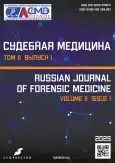通过判别分析,根据骨盆骨测量法特征确定性别
- 作者: Peregoroda S.A.1, Zaichenko A.A.1
-
隶属关系:
- Saratov Medical University named after V.I. Razumovsky
- 期: 卷 11, 编号 1 (2025)
- 页面: 16-24
- 栏目: 原创研究
- URL: https://journal-vniispk.ru/2411-8729/article/view/287946
- DOI: https://doi.org/10.17816/fm16208
- ID: 287946
如何引用文章
全文:
详细
理由。法医学的一个现实性问题是从骨骼遗骸中识别个人性别。通过独立骨骼确定性别是一项十分困难的任务。因此,人们十分关注通过独立骨盆进行性别鉴定的可能性。
目的。 通过骨盆骨测量法特征,采用多维判断分析及其准确性评估,开发确定躯体性别的方法。
材料和方法。研究对象 - 年龄18至86岁的男女骨盆骨(n=84),(以V.I.拉祖莫夫命名的萨拉托夫国立医科大学人体解剖学系的标本),以及11块男性(19-76岁)和14块女性(18-80岁) 骨盆骨(卢甘斯克国立医科大学人体解剖学、外科手术和局部解剖学系标本)。使用大厚圆规、滑动圆规和厘米尺按照V.P.阿列克谢耶夫方法进行测量。通过逐步判别分析建立分类模型。
结果。获得具有一组变量的模型,可以在考虑骨测量特征的情况下,确定骨遗骸的性别。模型识别的准确率为90.4%。在验证组进行测试时,取得了84%的准确率。数学模型中使用的以下尺寸显示出具有统计学意义的差异,即骨盆高度、坐骨高度、髋臼最大直径(p<0,01)。
结论。该研究建立了一个数学模型,可结合7个骨盆骨测量参数,用其进行骨遗骸性别鉴定,该模型的理论准确率和实践准确率分别为90.4%和84%。
作者简介
Sergey A. Peregoroda
Saratov Medical University named after V.I. Razumovsky
编辑信件的主要联系方式.
Email: sergej.peregoroda@gmail.com
ORCID iD: 0009-0004-0823-778X
SPIN 代码: 2011-4352
MD
俄罗斯联邦, 112 Bol’shaya Kazach’ya st, Saratov,410012Aleksandr A. Zaichenko
Saratov Medical University named after V.I. Razumovsky
Email: zaichenko1958@mail.ru
ORCID iD: 0000-0003-3683-6507
SPIN 代码: 9344-4417
Scopus 作者 ID: 7006414488
MD, Dr. Sci. (Medicine), Professor
俄罗斯联邦, 112 Bol’shaya Kazach’ya st, Saratov,410012参考
- Yankovski VE, Fominykh SA, Pivovarov AV, Belyaev IA. On the possibility of sex definition based on sections square of radial bones' distal metaepiphysis. The Siberian Medical Journal. 2009;24(3-1):61–63. EDN: KZIGLJ
- Semyonov VV. Revisiting the definition of the gender identity of the skeletal bones. Forensic Examination of Belarus. 2016;2(3):51–56. EDN: YLPTJV
- Chertovskikh AA. Procedure for sex determination of human scapula. Russian Journal of Forensic Medicine. 2020;6(1):33–35. doi: 10.19048/2411-8729-2020-6-1-33-35 EDN: XIJHRQ
- Dixit SG, Kakar S, Agarwal S, Choudhry R. Sexing of human hip bones of Indian origin by discriminant function analysis. Journal of Forensic and Legal Medicine. 2007;14(7):429–435. doi: 10.1016/j.jflm.2007.03.009
- Anuthama K, Shankar S, Ilayaraja V, et al. Determining dental sex dimorphism in South Indians using discriminant function analysis. Forensic Science International. 2011;212(1-3):86–89. doi: 10.1016/j.forsciint.2011.05.018
- Afrianty I, Nasien D, Kadir MRA, Haron H. Determination of gender from pelvic bones and patella in forensic anthropology: a comparison of classification techniques. In: Proceedings of 2013 1st International Conference on Artificial Intelligence, Modelling and Simulation; Kota Kinabalu, 2013 Dec 3–5. Kota Kinabalu: IEEE; 2013. P. 3–7. doi: 10.1109/AIMS.2013.9
- Alekseev VP. Osteometry. Methods of anthropological research. Moscow: Nauka; 1966. (In Russ.)
- Garmus AK. Forensic criteria for identification of a person based on a skeletal pelvis [dissertation]. Leningrad; 1990. (In Russ.)
- Phenice TW. A newly developed visual method of sexing the os pubis. American Journal of Physical Anthropology. 1969;30(2):297–301. doi: 10.1002/ajpa.1330300214
- Buikstra JE, Ubelaker DN, editors. Standards for data collection from human skeletal remains: proceedings of a seminar at the field museum of natural history. Fayetteville: Arkansas archeological survey; 1994.
- Bass WM. Human osteology: a laboratory and field manual. 5th edition. Columbia: Missouri archaeological society; 2005.
- Gaivoronsky IV, Fandeeva OM, Nikolenko VN, et al. Somatic sex determination of an adult by bone remains (rewiev). Saratov Journal of Medical Scientific Research. 201915(3):683–690. EDN: GVVLMQ
补充文件







